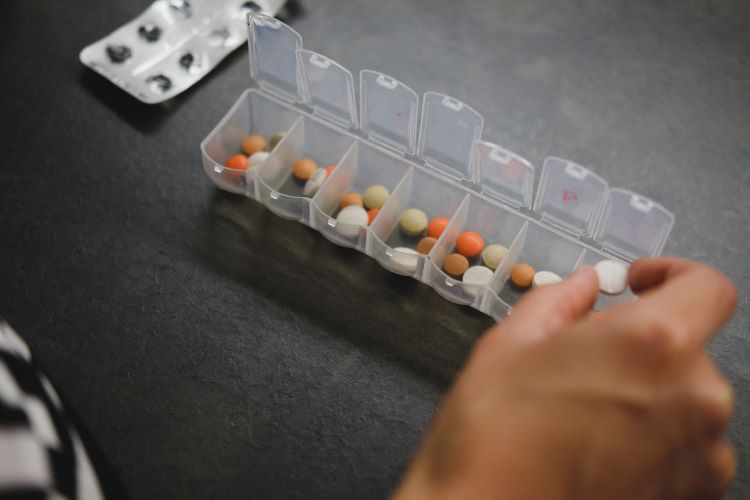Disulfiram for the Treatment of Alcoholism
Quick links for Disulfiram (Antabuse)
- How Disulfiram works
- Using Disulfiram
- Disulfiram within the wider treatment programme
- Medicinal substitutes used alongside Disulfiram
- Therapies used alongside Disulfiram
- What are the side effects of Disulfiram?
- Things to remember about Disulfiram
- References for Disulfiram
Around the world, millions of people are affected by alcoholism. It can be a devastating condition, ruining an individual’s physical health and putting them through mental and emotional torment.
Treating alcoholism is a complex balance between helping both the mind and body.
A popular method within this process is the prescription of Disulfiram (brand name Antabuse), a drug that aims to help an individual by heightening their body’s sensitivity to alcohol.
While effective, Disulfiram cannot be used in isolation. The drug only looks to help an individual in the short-term and therefore works best when used in conjunction with other treatment methods, including other medications and specialised therapies.
How Disulfiram works

Patient speaking with a medical professional about how Disulfiram works
When an individual drinks alcohol, the body begins metabolising it into a substance called Acetaldehyde. [1]
This is known to be very toxic, causing many of the effects associated with being hungover, such as vomiting and headache.
Under normal circumstances, the body constantly processes this Acetaldehyde into a neutral substance called Acetic acid, which does not cause any negative effects.
Only when an excessive amount of alcohol is consumed does the build-up of Acetaldehyde occur.
When an individual takes Disulfiram, this process is halted. The production of Acetic acid is stopped, and the consumption of alcohol causes a sudden build-up in Acetaldehyde.
Without it being broken down, the quantity associated with excess drinking accumulates.
Ten times the normal amount of Acetaldehyde is produced, and this causes an individual to experience hangover symptoms very soon after drinking.
Without having consumed anywhere near a dangerous amount of alcohol, an individual quickly experiences its harmful effects without the ‘high’ of being drunk. This results in them not wanting to drink again.
Using Disulfiram

Person taking Disulfiram for alcohol addiction
Due to its effects, it is important that an individual only takes Disulfiram under the supervision of a medical professional. [2] There can be a huge toll on the body when an individual drinks, so health must be monitored.
The drug must also only be prescribed following an individual’s successful detox from alcohol dependence.
It is only effective when taken by an individual dedicated to remaining sober, and those who are still unsure about their relationship with alcohol may come to harm if they consume large quantities while on Disulfiram.
It is essential that an individual be completely educated on the effects of Disulfiram. They must agree to the risk of drinking after having taken the substance, and be completely aware as to why their body is reacting so adversely.
Disulfiram within the wider treatment programme

Two people discussing the role of Disulfiram in a treatment programme
Disulfiram is considered to be an effective means of preventing short-term alcohol use.
The negative sensations it triggers cause an individual to not want to drink, but this effect cannot prevent a long-term relapse.
As a result, the drug is most effective as part of an overall alcoholism recovery plan.
It does not ‘cure’ the condition on its own, but works in conjunction with other treatment methods at an alcohol rehab near you.
For example, the drug does not reduce the impact of withdrawal symptoms, nor does it dampen an individual’s alcohol cravings. These things can be helped in other ways, and so Disulfiram must be combined with other treatments in order to achieve its optimum effectiveness.
Medicinal substitutes used alongside Disulfiram

Doctor typing out a prescription for Disulfiram
Following a successful detox from alcohol, it is common for individuals to continue to have strong cravings for it. In fact, many within their first year of leaving rehab have a relapse as a result of unbearable cravings. [3]
When cravings occur, it is common for them to trigger withdrawal symptoms.
These might include shaking, diarrhoea or vomiting – for many individuals, they can resurface even after a successful detox.
In the event of this, Disulfiram will be unable to help. It functions to take away the pleasure of drinking alcohol, but it cannot correct the chemical imbalance of the brain left by its absence.
Instead, Benzodiazepines can be prescribed. This category of drugs works by stabilising the chemistry of the body and preventing withdrawal symptoms from occurring.
By doing this, Benzodiazepines work in tandem with Disulfiram.
If an individual’s body chemistry is an incomplete imbalance, the harmful response to alcohol that is induced by Disulfiram will not be appreciated.
Their cravings will dictate their behaviour, and no new associations will be developed.
With withdrawal symptoms being kept at bay, however, an individual has the capacity to appreciate the negative effects that drinking alcohol is causing. They are able to associate the horrible symptoms they are experiencing with alcohol, and therefore no longer want to drink it.
This is the main reason why Disulfiram can only be used after detox. If an individual cannot handle their withdrawal symptoms and feels as though they must drink, the negative effects of the medication will not be enough.
However, if used in conjunction with medication that eases these symptoms, it has a greater effect.
Therapies used alongside Disulfiram

People in therapy for alcohol addiction
Alcoholism is primarily a matter of physical dependence on alcohol. However, that does not mean that there is no psychological aspect to the disorder.
For many people, the desire to drink stems from thought processes and feelings – often induced by mental health conditions – which they are unable to effectively cope with.
Because of this, Disulfiram will not be able to completely help an individual’s alcoholism on its own.
It will cause their body to react, but this reaction is useless if they do not confront their underlying desire to drink. [4]
For an individual to make significant progress, they must identify what effect their inner thoughts and feelings have on them. Cognitive Behavioural Therapy (CBT), for example, is a good method of achieving this.
Within CBT, an individual works with a counsellor to identify what thoughts and emotions trigger them to want to drink.
They look at what situations provoke these feelings, as well as what impact any mental health conditions might be having (anxiety, depression, schizophrenia, bipolar disorder, post-traumatic stress disorder, etc.)
Together, an individual and their counsellor work to identify the negative effects of these tendencies and develop alternative, healthier ways of responding.
They work to establish different ways of coping other than alcohol.
Disulfiram works along this process by helping an individual distinguish alcohol as being an ineffective coping mechanism. If they can learn that alcohol will harm them instead of help them, they will find it easier to seek and practice alternative methods.
What are the side effects of Disulfiram?

Man suffering from the side effects of Disulfiram
Compared to other alcoholism rehab treatments, Disulfiram has very few side effects.
They do still occur but tend to only last for a few weeks.
Common Disulfiram side effects include: [5]
- General drowsiness or fatigue
- Acne and skin breakouts
- Headache
In some circumstances, more serious effects may occur. These are less common, but they can affect health in a much more dramatic way.
Serious side effects include:
- Liver failure
- Psychosis
- Heightened sensitivity to other substances
- Delirium
- Hepatitis
Things to remember about Disulfiram

Two women discussing using Disulfiram in alcohol addiction recovery
Due to its significant effects on the body, it is important to take care before taking Disulfiram.
It is important to note that the drug’s effects will be triggered when any form of alcohol enters the body, including that which is inside products other than drinks.
As a result, take special care when using mouthwashes, vinegar, sauces, medicines, and any other products which may contain alcohol.
Furthermore, it is important to remember that you should not consume alcohol either before or after taking the drug. If there are traces of alcohol and Disulfiram within the body at the same point, even if one or the other has not been taken for a while, the aggressive reaction will still occur.
Therefore, alcohol must not be consumed within 12 hours prior to starting Disulfiram medication, and it should not be consumed for several weeks after use of the drug has been discontinued.
Disulfiram can be a cornerstone of alcohol addiction recovery, but it is only one step in beating addiction.
Residential and outpatient rehab services will be able to give you the professional and personal support you need to beat addiction once and for all.
Discover your options for a rehab near you here.
References for Disulfiram
[1] https://www.ncbi.nlm.nih.gov/pmc/articles/PMC6527032/
[2] https://www.ncbi.nlm.nih.gov/books/NBK64036/
[3] https://www.ncbi.nlm.nih.gov/pmc/articles/PMC3277871/






